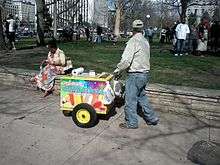Paletero

A paletero, alternatively paletero man is a street seller of paletas and helados (ice-cream), usually from a pushcart called a paletería. The word paletero does not have an English translation and it can be classified with other loanwords.
Origin in Mexico and spread to the United States
Spaniards introduced ice cream to North America during the European colonization of the Americas. In the 20th century, technology and investment expanded the ice cream sector. During the Mexican Miracle, paletas were introduced and in the 1930s ice cream chains were funded. Paleteros emerged in the town of Tucumbo in the state of Michoacan, Mexico where much of the population worked in agriculture. Emigrants from the area introduced palateros to the United States when they migrated there to work as temporary agricultural workers under the Bracero programs from 1942.
Cultural meaning of paletas and helados
Transnationalism
Paletas are not only a dessert but reflect the paleteros' own cultural identity, representing a cultural tradition of frozen treats in Mexico. The paletas are a dessert that carries Latin American culture across borders. "Carlos finds a little piece of home selling paletas. In a city where 30 percent of the population is Latino, according to the San Jose City demographics website, the Mexican tradition of peddling goods on the street thrives". Many street vendors migrate to the United States in search of economic stability but do not have the documents or legal status required to move up the economic ladder.
Pushcarts
The pushcart or carrito paletero is more than just a way of delivering paletas to buyers but also represent economic means for new immigrants. One can obtain a pushcart by working for a paleteria or one can buy one independently.
Vending requirements
In San Jose, California, a permit to sell paletas costs about $154. A county health department sticker costing $107 is also needed, stating that the product is safe for consumption. Paleteros undergo a background check, fingerprinting, and a drug test at the police department where they are issued an identification card costing $218. Paleteros can be fined $278 for selling paletas without a permit. These costs vary depending on location and make it difficult for new immigrants to make profits, because of their legal status and small profit margins. On average, a person makes 40-60 cents from each paleta.[1] Paleteros must have a valid identification, a social security card, and a clear permit record.[2]
References
- ↑ "San Fernando's Paleteros Reap Sweet Profits but Risk Arrest". latimes. Retrieved 27 May 2015.
- ↑ StreetVendors.pdf
- ↑ laverrán, Virginia González. "Historia del Helado en México By Martin González de la Vara ." Historia Mexicana 40 .2 (1990 ): 350-354.
- ↑ Ortiz, Laura Velasco. "La Michoacana. Historia de Paleteros de Tocombu by Martin González de la Vara ." Historia Mexicana 58.1 (2008): 509-516.
- ↑ Zuñiga, Ricardo Miranda. "Vagamundo: A migrant's Tale ." (n.d.).http://dl.acm.org/citation.cfm?id=1027762&bnc=1